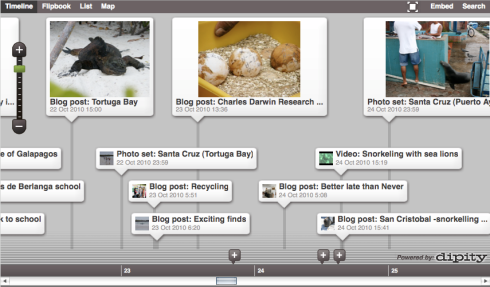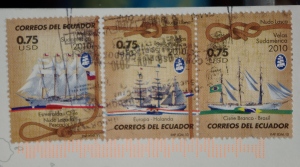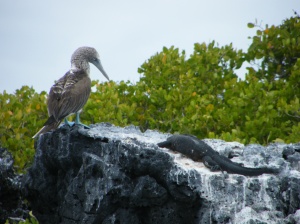In October 2010, the four winners of the Survival Rivals competition (Jessica Woodfield, Charlotte Woodfield, Becky Hill and Eleri Morgan from St Cyres School in Penarth, Wales) together with two of their teachers (Nicholas Alford and Sue Benjamin), two of the competition’s organizers (Amy Sanders of the Wellcome Trust and Amy Turner of Ignite!) and I (Karen James, then a postdoctoral scientist at the Natural History Museum in London) traveled to the Galapagos archipelago for two weeks.
Our aim was not only to enjoy the unique natural environment that inspired Charles Darwin’s theory of evolution by natural selection, but also to capture our experience the way Darwin did. That is, we would record our experiences, ‘specimens’, thoughts, connections and speculations – not using a pen and a red notebook, but Twitter, Flickr and YouTube.
At the end of each day or few days, we would raid our tweets, photos, videos and memory banks and write a short, illustrated blog post (using WordPress). And, at the end of the trip, all of this would serve as our source material for our own version(s) of Darwin’s Journal of Researches (better known now as Voyage of the Beagle), an e-Book to be written and published approximately six months after the trip.
Darwin used layers of increasingly formal writing tools — field notebooks & specimens ➙ diary ➙ book — and so will we, except that our technology will be a little different: Twitter, Flickr and YouTube ➙ Blog ➙ e-Book.
By the end of the trip, we had published a very large volume of primary material: 62 blog posts, 514 Flickr photos and 17 YouTube videos. Concerned about how to represent the strong multimedia component, and inspired by an interactive timeline I had seen in one of Ed Yong’s Not Exactly Rocket Science blog posts, I decided to use Dipity to create an interactive timeline to complement the e-Book.
The e-Book is now available in PDF format here. Here is a screenshot from the original Interactive Timline made with Dipity, which, as of this edit (April, 2020) no longer exists.









